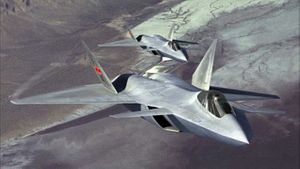Earlier this week, Secretary of Defense Ash Carter refused South Korea’s request to reconsider the transfer of four technologies associated with stealth aircraft.
The tech transfer was part of a larger deal intended to deliver 40 F-35 Joint Strike Fighters to South Korea, along with 25 technologies associated with the program. These technologies would have jump-started the RoK’s own stealth fighter program. However, the State Department (advised by the Department of Defense, hence the direct request to SecDef Ash Carter) quashed the transfer of four of the twenty-five technologies.
This decision is part of a long-standing system of export controls, initially designed to preserve the West’s technological advantages over the Soviet bloc. While Soviet industry was capable of many things, it struggled to keep pace with Western technological innovation, especially in the tech sector. Export controls were expected to prevent the Soviet Union from injecting new technologies into its defense-industrial base. Now, military export controls protect U.S. technological advantages from Russia and China.
While the U.S. does not expect South Korea to relinquish such tech to either (and the U.S. retains veto rights over the export of equipment with U.S. components), the proliferation of know how makes the technology less secure. Moreover, while export controls are intended to evaluate only security concerns, the U.S. government could also use the export control system to prevent the transfer of technologies that might prove detrimental to U.S. commercial military advantages. The KF-X may eventually prove a export competitor for the F-35, and its absence may force the Koreans to buy more Joint Strike Fighters.
The four technologies in question are the active electronically scanned radar, the infrared search-and-rescue systems, the electro-optical targeting pod and the radio frequency jammer. Reports indicate that Korea will attempt to develop the latter two technologies indigenously, and the former two in cooperation with foreign (non-US) industry. The remaining technologies are certainly relevant to the future of the South Korean military industrial complex, and hundreds of American engineers are expected to soon begin work with their Korean counterparts.
So where does this leave the U.S. and South Korea? The decision has produced a firestorm of criticism in Seoul, some directed at the United States, and some directed at a government which looked unprepared for the highly likely eventuality of a DoD veto. The KF-X program is in trouble; it was intended to provide 120 fighters for South Korea (and another 80 for Indonesia) between 2025 and 2030. As Dev Majumdar notes, it is unlikely that South Korea will be able to develop all of the relevant technologies (or acquire them from other sources) in a timely fashion. The DoD decision could lead to a cancellation of the entire F-35 deal, which would leave Korea without a fifth generation fighter for the foreseeable future.
The fact that Airbus recently won the Republic of Korea Air Force (ROKAF) contract for an in-flight refueling may bode poorly for the future of U.S. tech collaboration with South Korea. If the Europeans establish themselves as reliable suppliers of both technology and equipment, the long-standing procurement relationship between Washington and Seoul may fade. That said, South Korea will continue to depend on specific, advanced U.S. military technologies for quite some time.































